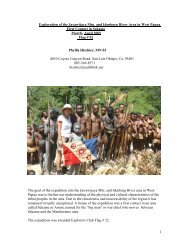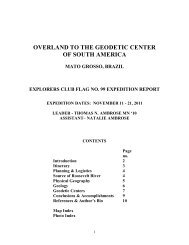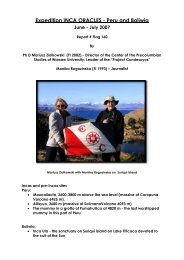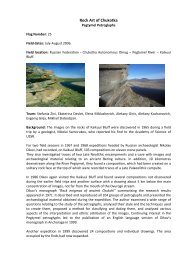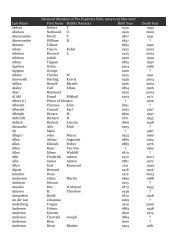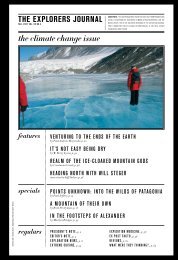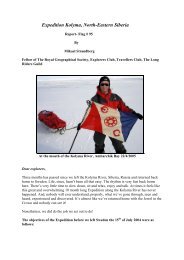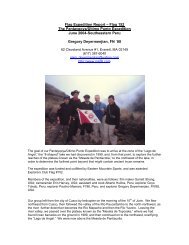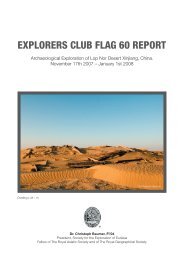the explorers journal - The Explorers Club
the explorers journal - The Explorers Club
the explorers journal - The Explorers Club
Create successful ePaper yourself
Turn your PDF publications into a flip-book with our unique Google optimized e-Paper software.
A FAR OUT ISSUE SPECIAL<br />
E x t r e m e C u i s i n e<br />
food for <strong>the</strong> epicurean adventurer<br />
F u t u r e F o o d s<br />
dining well beyond <strong>the</strong> van allen belt<br />
"Among <strong>the</strong> challenges for interplanetary missions is<br />
that food will have to be resistant to degrading due<br />
to exposure to radiation," says Charles T. Bourland,<br />
former director of NASA's space food program and coauthor<br />
of <strong>the</strong> recently releASED ASTRONAUT'S COOKBOOK<br />
(SEE PAGE 59). SPACE FOODS, HE NOTES, MUST ALSO be loaded<br />
with antioxidants to counter <strong>the</strong> effects of radiation<br />
on <strong>the</strong> crew and have plenty of calcium to arrest<br />
bone loss. ANOTHER THING HE SUGGESTS WE CONSIDER IS<br />
THAT THESE FOODS WILL BE MADE primarily FROM PLANTS<br />
AND CELLULAR MATRICES PROPAGATED IN SPACE, WHICH WILL<br />
RESULT IN A LARGELY VEGETARIAN DIET. NONETHELESS, SAYS<br />
BOURLAND, IT IS POSSIBLE THAT THE COMPUTER-CONTROLLED<br />
FOOD SYNTHESIZERS MADE POPULAR BY SCIENCE FICTION<br />
MAY ONE DAY OFFER A HOST OF TEXTURED PRODUCTS, which<br />
will PROVIDE TASTE SENSATIONS we fondly ASSOCIATE WITH<br />
FAVORITE DISHES HERE ON EARTH.<br />
56<br />
Such offerings are already taking hold in <strong>the</strong> culinary<br />
world in <strong>the</strong> form of "molecular gastronomy," a scientific<br />
discipline launched in 1988 by Oxford physicist<br />
Nicholas Kurti and Hervé This, now scientific director<br />
of <strong>the</strong> Fondation Science & Culture Alimentaire in<br />
Paris. Its purpose: to use <strong>the</strong> tools of physics, chemistry,<br />
and biology to investigate <strong>the</strong> process of culinary<br />
transformation—why, for instance, a soufflé swells.<br />
"Take an egg for example," says This. "If we heat it,<br />
water evaporates and <strong>the</strong> proteins denature and polymerize<br />
to enclose water. <strong>The</strong> result is a cooked egg.<br />
But is <strong>the</strong>re ano<strong>the</strong>r way to do this <strong>The</strong> answer is yes,<br />
with alcohol, which also denatures proteins. If you put<br />
a whole egg in alcohol, and you are patient enough, <strong>the</strong><br />
ethanol will permeate <strong>the</strong> shell and promote coagulation.<br />
After a month, <strong>the</strong> result is a strange coagulated<br />
egg called a Baumé, after <strong>the</strong> French chemist Antoine<br />
1970s artist's concept of human settlement in space. image courtesy NASA



